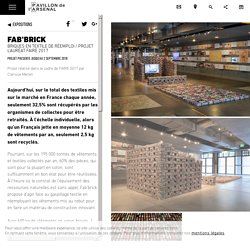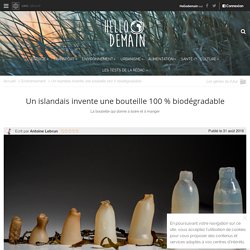

Expositions. Projet présenté jusqu'au 2 septembre 2018 Projet réalisé dans le cadre de FAIRE 2017 par Clarisse Merlet Aujourd’hui, sur le total des textiles mis sur le marché en France chaque année, seulement 32,5% sont récupérés par les organismes de collectes pour être retraités.

À l’échelle individuelle, alors qu’un Français jette en moyenne 12 kg de vêtements par an, seulement 2,5 kg sont recyclés. Biointelligent Membranes : It's The End of the World As We Know It - MaterialDistrict. What will the world be like in 2100 and what kind of materials will we be wearing?

Cathrine Disney speculates on a material future in a world dramatically impacted by climate change with these Biointelligent Membranes. This textiles project finds us in the year 2100, in a world where the effects of climate change caused by the unrestricted burning of fossil fuels has lead to extremes of temperature ranging from a low of -93.2°C to a high of 70.7°C.
As a result, the types of clothing we wear today are no longer an appropriate way of protecting our bodies from the harsh environment around us. Tjeerd Veenhoven: Material and Product Design, Abendvorträge im Rahmen der Ph.D.-Lehrwoche Bauhaus Universität Weimar. Un islandais invente une bouteille 100 % biodégradable - Hellodemain. On ne compte plus les déchets plastiques gisant sur le sol, même dans les endroits les plus sauvages et reculés du monde.

Et ça, Ari Jónsson en a eu ras la casquette. Alors ce jeune étudiant islandais a inventé une bouteille 100 % naturelle qui se dégrade automatiquement une fois vide. La recette : une poudre d’algues rouges et un peu d’eau. L’algue est décidément sur tous les fronts. Recyclamine Demo. Sheep Poo Paper. Metamaterial mechanisms made from a single piece of plastic.
Des micro-algues aux BioPolymères. Pour remplacer le pétrole, les micro-algues sont particulièrement prometteuses.

Une équipe de l’école des Mines d’Alès s’attache à produire des bioplastiques issus de ces algues, le plus simplement possible. Mestic: bioplastic made from cow dung. An average cow eats about 50 kilograms of grass per day, which means that it also produces a lot of poo.

Cow dung contains phosphate and nitrogen, which, in small dosages, is beneficial for the soil. Unfortunately, because of the large amount of cows, the agricultural sector produces a surplus of manure, which is harmful for the soil, water and air. Earlier we reported on a company that made ceramics with cow dung. With the project Mestic, designer Jalila Essaïdi and her team have found a way to turn manure into bioplastic. The word Mestic derives from the Dutch word for manure (‘mest’). The Polyfloss Factory on Vimeo. BioMason's bricks "grown" with sand and bacteria to hit the market next year.
BioMason is inching closer to commercially debuting its eco-friendly “grown” bricks, which they say could be on the market as early as next year.

Since its founding in 2012, the North Carolina startup has been pushing to revolutionize the world of building materials in a way that slashes carbon emissions by using bricks grown from sand and bacteria, instead of firing traditional bricks. An increasing number of architects and builders are looking to sustainable construction materials in response to the growing demand for green buildings, and BioMason’s emission-saving biobricks fill a unique niche in the market. BioMason’s efforts, under the directions of founder and CEO Ginger Krieg Dosier, have been garnering attention in the green construction industry for several years. New Material Could Allow Divers to Breathe Underwater Without Oxygen Tanks. If you’ve dreamed of being able to hang out underwater without the tether of an oxygen tank, get ready for your dream to become reality.

Scientists have created a crystalline material that can actually pull oxygen out of the surrounding environment, and it could mean no more oxygen tanks – underwater or on dry land. The material is made from cobalt and it can pull and release oxygen without the need for bulky storage tanks. Just a few grains of the material are all that is needed to store enough oxygen for a breath, so toting around the material would be easy and light – light enough that swimmers could go for an extended dive without being weighed down and lung patients who require oxygen could leave the oxygen tank at home.
Some are calling the material the ‘Aquaman crystal’ given that it seems to almost imbue an individual with superhero-like capabilities. RE-SEA ME. Genspace - Project - GENSPACE & BIOFABRICATE 2015 Bio Pigments Workshops. Bio Pigments Workshops GENSPACE & BIOFABRICATE 2015 When: Friday, Oct 23rd, 2015 Where: GENSPACE The MEx Building, 5th Fl.33 Flatbush Avenue, Brooklyn NY 11217 *A special Day-Ticket offer for both sessions:Pili.bio GROW YOUR OWN INK 11am-2pmNatsai Chieza FABER FUTURES 3-6pm We’re entering a new Material Age.

It is driven by creativity, sustainability and environmental responsibility. Pollution-free furniture of the future will be grown from mushrooms. The furniture of the future might not be built, but grown.

New York-based nonprofits Terreform ONE and Genspace developed a series of benches created from Mycoform, a durable and 100% compostable material made from mushrooms, wood chips, gypsum, oat bran, and other biological materials. The designers say the Mycoform production process is pollution-free, low-tech, and low-energy. The Mycoform structure is grown from molded agricultural byproducts inoculated with the fungal species Ganoderma lucidum. Once placed in a warm and humid environment, the fungi fuses the organic substrates together using mycelium, the vegetative part of the fungus that consumes the byproducts’ cellulose components to create a branch-like network. The branching mycelia grow rapidly into a weight-bearing structure. Related: Philip Ross Molds Fast-Growing Fungi Into Mushroom Building Bricks That Are Stronger than Concrete + Terreform ONE. Bouillon de culture. Du plastique sans pétrole, c'est possible grâce à une algue OGM. SCIENCE - Chaque année, nous produisons plus de 288 millions de tonnes de plastique.

Au-delà du problème du recyclage et de l'abandon de ces déchets dans la nature, un autre défi est encore à relever sur notre consommation de ces produits: leur origine. Car pour créer du plastique, il faut transformer du pétrole (ou du gaz), ce qui produit beaucoup de dioxyde de carbone (CO2). Cette invention sauvera des milliers de vie. Voici le pansement du futur.
Cette invention sauvera des milliers de vie. Voici le pansement du futur ! Parfois, la science-fiction rejoint la réalité. Comme avec ce gel organique inventé par une petite équipe de chercheurs américains. Sa particularité ? Arrêter instantanément une hémorragie. En Charente-Maritime, la deuxième vie des huîtres. COLLECTE. Le Piñatex, un textile d'origine végétale durable. Studio Nienke Hoogvliet - RE-SEA ME. RE-SEA ME is the continuation of SEA ME. To show the duality between plastic waste in the oceans and the sustainable materials the oceans have to offer, Nienke continued her search for materials out of the sea. She discovered that fish skins are a waste product of the fishing industry, while you can also make them into beautiful leather. She went to fish shops to collect their waste and discovered a way of tanning the skins without any chemicals. By using an old technique, that requires a lot of manual labour, she created a strong, sustainable and beautiful material that can be used like regular leather.
To show the abilities of the leather, Nienke designed a small stool with fish leather seating. For this project Nienke used salmon skins, but almost any kind of fish can be used to make leather of. With this project she would like to raise awareness for the waste issues we have with the oceans. Le Piñatex, un textile d'origine végétale durable. Eben Bayer: Are mushrooms the new plastic? Vocativ. Sand packaging — alien and monkey. Varian by Culture iN. Caméra sous-marine, Algopak et sang marin - FUTUREMAG #13 - ARTE.
Loam Clay Earth, Martin Rauch, Vorarlberg. Rammed-Earth Walls Interiors Rammed-earth interior walls have, above all, positive impacts on indoor climate. Materials Monday: Watershed Materials turns rammed earth into a building block. Concrete is a problem from start to finish. The production of cement is responsible for at least 5% of the CO2 made by humans each year. That cement is mixed with aggregate that is carted out of huge earth-scarring gravel pits by giant trucks. It is then put in redi-mix trucks that race through cities before the clock runs out on the mix, and have a tendency to squish cyclists. Sable et soleil au service de l'impression 3D. Linen & hemp community - Le lin & le chanvre européens. Microalgues, le futur or vert.
Ecovative. Futurism - Say 'Goodbye' to Cracks, Self-Healing Concrete...